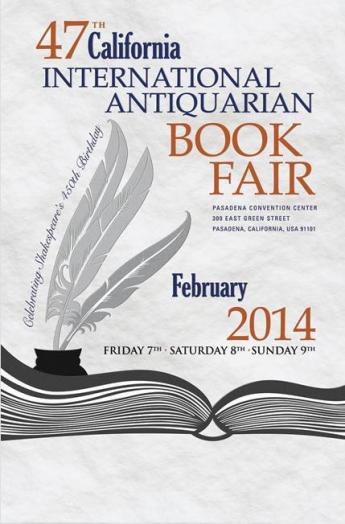Antiquarian Booksellers' Association of America Ten Pound Island Book Company
Rare Book Dealers - Bank On It

By Greg Gibson
I taught at CABS (Colorado Antiquarian Book Seminar) a few years ago, once as the featured specialist dealer, and once pinch hitting for Rob Rulon-Miller.
I went there thinking it would be like a week in summer camp – book stories, hikes, and handicrafts. I came away deeply impressed with the level of commitment on the part of the faculty, the seriousness with which they took their roles as instructors, and the level of information, all of it useful, imparted during that intense week in Colorado Springs. We trained for books with the same intensity as the Olympic athletes who trained just down the street.
To be sure, we talked about important things pertaining to the history and physical makeup of the book, about researching, cataloging, and marketing our wares, and about such exotic topics as performing appraisals or bidding at auction. But for me, the most important thing we discussed was cash flow. You could be the sharpest scout, or the greatest bibliographer in the world. But if you couldn’t keep the money flowing through, your business was doomed.
As it has so often in the past, that message resonated recently. I’ve completed my book fair marathon (three shows in three weeks), have selected, cataloged and shipped the items I will be exhibiting in the next two weeks at the San Francisco Antiquarian Book and Paper Fair, and the 47th California International Antiquarian Book Fair in Pasadena, and now I am staring at the wreckage of my office, realizing that over the past two months most of my accounts receivable have come in and been spent, and that I’ll soon be facing the expenses of two weeks on the road.
Cash flow!
This inspired me to resume work on Maritime List 221, which had languished in a half-completed state over the Christmas holidays, and then went unattended while I hemorrhaged money buying books, meals, and drinks at far flung bookfairs. And, wouldn't you know, I came across a fascinating item in the course of my renewed cataloging activities. It was just an old pamphlet, but as I set about describing it, I realized it told the story of a pivotal moment in the life of an American community.
In 1795, after years of Quaker hand-wringing and debate over whether there was sufficient business to warrant it, a bank was established on Nantucket island. It hadn’t been in business long when three men broke in and stole $20,000. Joseph Chase, the bank’s president, soon decided a bank officer named William Coffin was behind the robbery. A bribe attempt was made to frame Coffin and his alleged cohorts, but it failed. Coffin then went off-island to investigate the crime himself, and learned that the robbery had been committed by a band of professional thieves. Although one of these men confessed the crime to bank president Chase, his testimony was suppressed. The robbery had moved beyond criminality into a power struggle among the Quaker elite. Tempers flared, threats were made, lawsuits were launched. The bitter split among residents caused by this incident reverberated down the decades. As Nat Philbrick says in his excellent book about Nantucket history, Away off Shore.
“It soon became apparent that the once idyllic community of Nantucket was in the midst of a cultural meltdown.”
Years later, William Coffin, the man falsely accused of the crime, learned that an inmate in New York State Prison had confessed to the crime. In 1816 Coffin, with the assistance of another accused man, published a pamphlet called Narrative of the Robbery of the Nantucket Bank in hopes of setting the record straight. Unfortunately the facts of the matter did little to heal the wounds it had caused. Obed Macy, in his iconic History of Nantucket sniffs, “To give a minute account of the transactions growing out of this affair, is not our intention or wish. The inhabitants of Nantucket, and all others acquainted with the circumstances,will appreciate our reasons for passing it over thus briefly.”
The robbery continued to divide the community, and later banking scandals only added to partisan quarrels on the island. Philbrick concludes, “Given the direct relationship that had historically existed between the community’s dominant religion and its ability to turn a profit, it was perhaps inevitable that banking debacles would accompany Quakerism’s gradual fragmentation and decline on Nantucket.”
Coffin, William and Albert Gardiner. A NARRATIVE OF THE ROBBERY OF THE NANTUCKET BANK. Nantucket. 1816. xviii, 69 pp. Sole edition of this early Nantucket imprint. Suspicion fell on locals and bank officials after the 1795 robbery. Coffin and Gardiner compiled compelling evidence to show that the robbery was actually the work of an organized gang of professional thieves. The repercussions divided Nantucket for decades. See Nathaniel Philbrick’s treatment of this incident in AWAY OFFSHORE. Crosby, p. 164. American Imprints 37286. A stab sewn pamphlet, with title page as front wrapper. Untrimmed; edges chipped and corners rounded. In and early Goodspeed’s mailer. $1250
Next week – San Francisco, here we are!
The 47th California International Antiquarian Book Fair
Pasadena Convention Center - 7th to 9th February, 2014
300 East Green Street
Pasadena, CA 91101
Friday 3 pm - 8 pm
Saturday 11 am - 7 pm
Sunday 11 am - 5 pm
For more information please visit the official website www.cabookfair.com.
(Posted on Bookman’s Log, presented here by permission of the author.)



